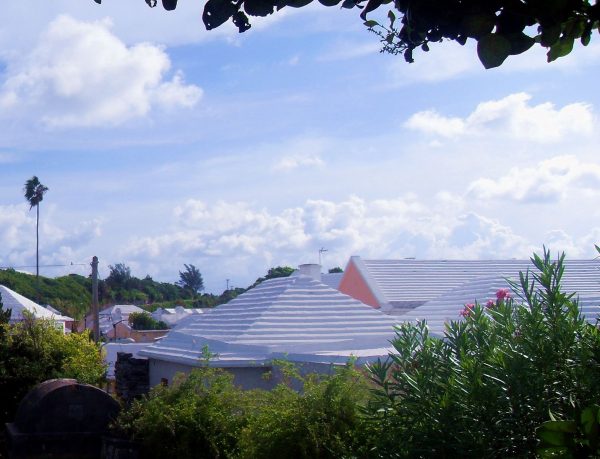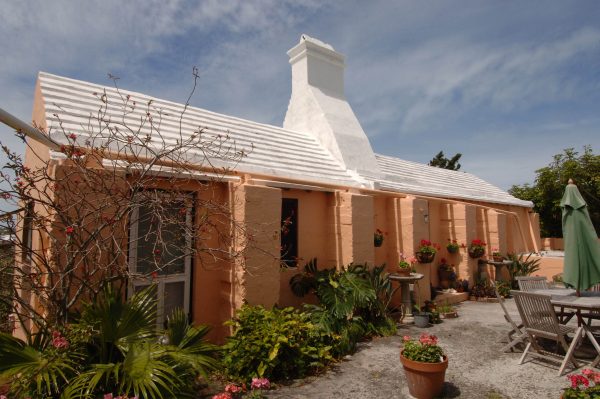Bermuda has a reputation for being a luxurious tourist destination, but visitors to the island’s posh hotels might miss out on a key resource restraint that drives local architectural design: a lack of water. 99% Invisible listener Amy Daniels wrote in to explain how the absence of freshwater lakes and streams coupled with annual hurricanes led to the development of a clever roofs that neatly suit the local climate.
 The bright white roofs “step up” in a very distinctive fashion, like staircases on four sides converging at the peak. These are “designed to catch rainwater and store it for use,” explains Daniels. But they are also built “to withstand the high winds of hurricanes.” They even “help keep the houses cool (as a semi-tropical island it gets very hot and humid).” Plus, they’re durable and “can last for centuries.” These designs are everywhere on the island, and with good reason.
The bright white roofs “step up” in a very distinctive fashion, like staircases on four sides converging at the peak. These are “designed to catch rainwater and store it for use,” explains Daniels. But they are also built “to withstand the high winds of hurricanes.” They even “help keep the houses cool (as a semi-tropical island it gets very hot and humid).” Plus, they’re durable and “can last for centuries.” These designs are everywhere on the island, and with good reason.
 Early houses made by the island’s first settlers employed wooden frames and frond-covered roofs, but wood was a scarce and valuable resource, so people began to turn toward stone. Bermuda is rich in limestone, which led to a productive symbiosis between excavation and construction: digging out space for foundations and basements naturally frees up great raw building materials for building robust homes. From there came so-called “Bermuda roofs,” which step upward and to Mark Twain’s eye looked like the frosting on a cake. The stone roofs are heavy, helping them withstand high winds when storms strike. They also collect remarkable amounts of water for residents.
Early houses made by the island’s first settlers employed wooden frames and frond-covered roofs, but wood was a scarce and valuable resource, so people began to turn toward stone. Bermuda is rich in limestone, which led to a productive symbiosis between excavation and construction: digging out space for foundations and basements naturally frees up great raw building materials for building robust homes. From there came so-called “Bermuda roofs,” which step upward and to Mark Twain’s eye looked like the frosting on a cake. The stone roofs are heavy, helping them withstand high winds when storms strike. They also collect remarkable amounts of water for residents.

The flat, stepped surfaces help gather and direct water, sending it down into expansive, on-site storage containers. Peter Backeberg of The Bermudian explains that “there are strict regulations in our building code that dictate both the water catching ratio for each roof (80%) and a minimum tank size per roof area (eight gallons per square foot).”
Over generations, improvements have been made to both the way these roofs are finished and how captured water is stored. Historically, the lime-covered white roofs also fortuitously had anti-bacterial properties, helping to clean the incoming rain. Even though the material composition has since shifted, the standard roof is still white, reflecting UV rays and thus helping to purify the water. The steps of the roof also come in handy when it comes to climbing up and repainting, which the government advises people to do every few years. These days, residents use long, specialized brushes to help with the work, too.

Visitors are not always subject to the same restrictions as residents, and could easily overlook the culture of water conservation that islanders are raised to respect. For locals, water-consciousness pervades everyday life. Baths are rare according to Hydrogeologist Shaun Lavis, who lives on the island. Simple things like brushing teeth or doing dishes are done deliberating with an eye toward cistern levels. Historically, since each house has its own tank, residents have learned to keep an eye on their reserves and plan around limitations.

As the island gets more crowded and built up, the ratio of roof to interior space is decreasing, adding to scarcity. These days, desalination tanks and more sophisticated groundwater harvesting techniques help supplement the island’s traditional system, in part due to the increased demand from off-island visitors. But even with new sources, water-consciousness remains part of the culture: “We all grew up managing our own water system in our own home and that drives you to have a sensitivity that you wouldn’t if it simply comes out of a pipe,” Alan Rance, Chief Executive Officer of Bermuda Waterworks, told the BBC.
Meanwhile, Bermuda roofs work so well they have started to be imported by other countries in the region looking to reduce storm damage, increase water storage and help cool off interior spaces. They are a local design born out of a specific place, but hold lessons for other places with similar conditions in terms climate, materials and water. More broadly, they are also a reminder that resilient innovation comes from necessity as well as intergenerational iteration.



Comments (3)
Share
I’m eagerly waiting for the world to wake up and realize that running out of oil is going to create a lot of necessity.
How do the steps in the roof aid in water collection? Are they pitched slightly to redirect water without requiring gutters?
This article needs diagrams. How does the step work in keeping the water? What thickness is the roof? It mentions the roof is painted, but not how the ceiling is structured or held up. I too live in a water-lacking country with heat and tall roofs, and thus I would love to see how the gutters are attached to the rain holding tanks, how they are attached to the roofs, and how the tanks made and are plumbed, but all it vaguely mentions is that there are cisterns holding the water for each house. This article lacks any content, and does not take the reader to Bermuda, as it ought.